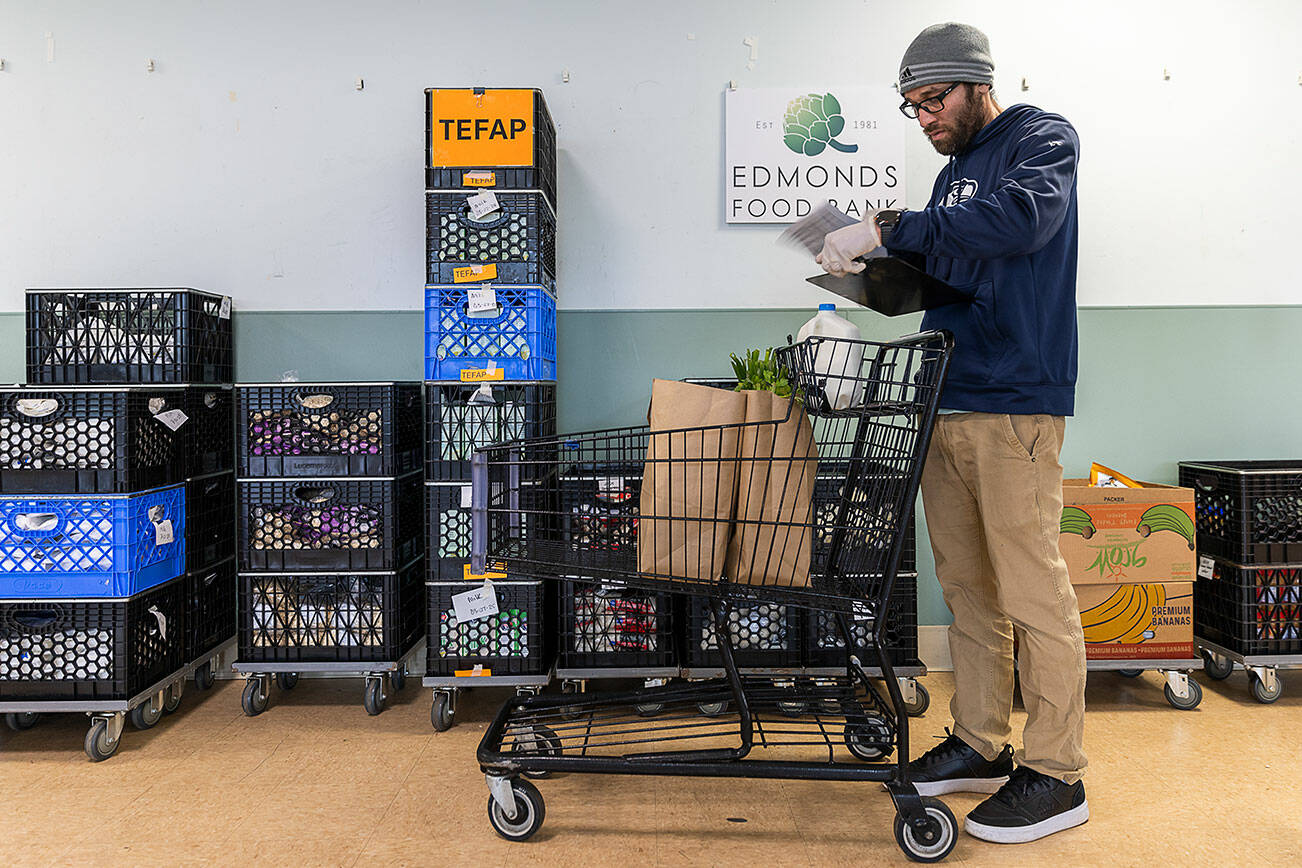Copyright Everett Herald

EVERETT — Snohomish County food banks are preparing for an influx of customers amid uncertainty for food assistance programs at the busiest time of the year for the nonprofit organizations. Food banks across Snohomish County were already reeling from cuts to federal funding and increased demand from residents needing assistance. But funding for the Supplemental Nutrition Assistance Program, known as SNAP, was set to lapse Saturday unless Congress passed a spending bill ending the government shutdown, or if the government tapped into emergency funds. SNAP — formerly known as food stamps — distributes benefits to about 42 million low-income Americans nationwide to buy nutritious food. On Friday, a federal judge ruled that the government must allocate emergency funding as soon as possible to maintain the food benefits. But it’s unclear if SNAP payments for November will be reduced or delayed, The New York Times reported. In 2023, the most recent year with data available, about 92,000 people in Snohomish County faced food insecurity, according to nonprofit Feeding America, just over 11% of the county’s population. Jessica Moore, the vice president of development at Volunteers of America Western Washington, which operates food banks in Everett and Sultan, said the organization has already been seeing an increasing need for food support. This year, Volunteers of America’s food banks served 10,500 people in one month, the highest rate in 25 years, Moore said. “If SNAP benefits aren’t distributed, we expect to see a major surge in families turning to us for help,” she wrote in an email Thursday. Casey Davis, the executive director of the Edmonds Food Bank and president of the Snohomish County Food Coalition, said “people are standing on the edge of a cliff.” “By coming to the food bank, we keep them up on top of that cliff,” she said in an interview Thursday. “But a whole bunch of them are standing out there. We’re about to have a quake that just calves off a whole section, and all those people are going to go at once.” Need has been increasing for the food banks even before the government shutdown began on Oct. 1. Across the Snohomish County Food Bank Coalition, which brings together nearly two dozen food banks across the county, the organization served 7,314 more individuals in September than it did in August, said Amy Howell, the executive director of the Marysville Community Food Bank. “It’s going to be interesting to see how everybody is going to be able to handle this influx of people needing services from all of us,” Howell said. “I know I’m scared.” The government shutdown — which has stretched nearly a whole month — raised uncertainty if the government would be able to distribute SNAP benefits to the millions of Americans who rely on them for food. On Oct. 24, the U.S. Department of Agriculture wrote in a memo that the agency could not legally use its contingency funds to continue SNAP payments after Nov. 1 if funding wasn’t restored, States Newsroom reported. In September, the Department of Agriculture had previously said that its contingency funds could continue benefits through the shutdown. On Tuesday, Gov. Bob Ferguson announced that the state Department of Social and Health Services would transfer about $2.2 million per week to the Department of Agriculture to provide grants to food banks. Ferguson’s announcement came just hours after the Washington Attorney General, Nick Brown, said the state had joined 21 others in suing the federal government over the looming halt to SNAP funding. In their lawsuit, attorneys general argued that the federal government had shuffled other money to provide funding for certain programs, but not SNAP, making the decision arbitrary and a violation of federal law, States Newsroom reported. In court, the Trump administration said it could not use contingency funds to cover the shortfall, arguing there were legal obstacles to transferring the money and budgetary constraints to the Department of Agriculture if it did so, The New York Times reported. The government shutdown began on Oct. 1, stemming from a fight over subsidies to the Affordable Care Act, known as Obamacare, that are set to lapse if not extended in a congressional funding bill. The Congressional Budget Office estimated that around 2 million Americans will become uninsured by the end of 2026 if those subsidies were to lapse. The average premiums for those who remain on Affordable Care Act coverage would also more than double, according to health research firm KFF. Both Republicans and Democrats have put the blame on each other for the impasse. The shutdown has meant 730,000 federal employees are working without pay, and another 670,000 are furloughed without pay, The New York Times reported. The government shutdown is not the only challenge facing SNAP. Congress also approved cuts to the food assistance program as part of a cost-cutting bill, approved in July, that extended tax cuts and cut social safety measures. Before the bill’s approval, military veterans, individuals who were homeless, aged 55 or older or were caring for a child under 18 were exempt from requirements to work at least 80 hours per month to be eligible for benefits. The new law changed those requirements to require military veterans and homeless individuals to work in order to be eligible. It also raised the upper age exception to 65 and older rather than 55 and lowered the dependent child exception to a parent caring for a child 14 years of age, rather than under 18. Those changes were made effective immediately, but a 120-day “hold harmless” period that protected states from errors related to the work requirement changes will end Saturday. The Congressional Budget Office estimated that about 3.2 million people would lose SNAP benefits from the changes. Those new requirements, combined with widespread layoffs in the tech industry and increased cost of living, are likely contributing factors to the increased need at food banks. “We’ve seen a completely unprecedented number of new client submission applications through our website,” said Sam Norris, the executive director of Stanwood-Camano Food Bank Services, said Thursday. “It’s shocking.” Food bank officials said the best way to help is by giving monetary donations, as the organizations purchase food from wholesalers at a lower price than at grocery stores. Many also give food banks discounts on top of the lower prices, Norris said. Funding also goes toward essential functions of the operations of the food banks, like gas for transporting large loads of food The nonprofits also accept food donations and need volunteers. “It just seems like we’re all in a state of ‘I’m overwhelmed,’ and I think people think they can’t do anything, what I do won’t matter,” Davis said. “But the reality is, what makes the difference is everybody in the community doing a little, doing what they can. When they have something to share, sharing it, when they need something, coming to us for support.” To donate to the Snohomish County Food Bank Coalition, which makes bulk purchases for 19 food bank organizations throughout the county, visit snocofood.org/donate. To donate to your nearest food bank or find volunteer opportunities, visit snocofood.org/locations. • Arlington Community Food Bank, 19118 63rd Ave. NE, Arlington. Donate: arlingtonfoodbank.org/contribute/ • Casino Road Food Pantries, 805 W Casino Road, Everett; 14 E Casino Road, Everett. Donate: voaww.org/donate • Darrington Food Bank, 1080 N Sauk Ave., Darrington. Donate: darringtonfoodbank.com/donate • Edmonds Food Bank, 828 Caspers St., L100, Edmonds. Donate: edmondsfoodbank.org/donate/ • Everett Community Food Bank, 1230 Broadway, Everett. Donate: voaww.org/donate • Westgate Chapel Emergency Services, 22901 Edmonds Way, Edmonds. Donate: westgatechapel.com/giving/ • Granite Falls Community Coalition, 307 N Adler Ave., Granite Falls. Donate: granitefallscommunitycoalition.org/needed-items • Lake Stevens Food Bank, 9428 4th St. SE, Lake Stevens. Donate: lakestevensfoodbank.org/donate • Lynnwood Food Bank, 5320 176th St. SW, Lynnwood. Donate: lynnwoodfoodbank.org/get-involved/give • Maltby Food Bank, 21104 86th Ave. SE, Snohomish. Donate: maltbyfoodbank.org/donate-and-volunteer/ • Marysville Food Bank, 4150 88th St. NE, Marysville. Donate: marysvillefoodbank.org/donate • Mountlake Terrace Concern for Neighbors Food Bank, 4700 228th St. SW, Mountlake Terrace. Donate: concern4neighborsfb.org/donate • Hope Creek Charitable Foundation, 4326 148th St. SE, Mill Creek. Donate: hopecreekcf.org/fund-hope/ • Salvation Army, 2525 Rucker Ave., Everett. Donate: everett.salvationarmy.org/everett_corps/ways-to-give/ • Sky Valley Food Bank, 233 Sky River Pkwy., Monroe. Donate: svfoodbank.org/support-us/ • Snohomish Community Food Bank, 1330 Ferguson Park Road, Snohomish. Donate: snohomishfoodbank.org/support/ • Stanwood-Camano Food Bank, 27030 102nd Ave. NW, Stanwood. Donate: stanwoodcamanofoodbank.org/about/ • Sultan Community Food Bank, 617 1st St., Sultan. Donate: voaww.org/donate



